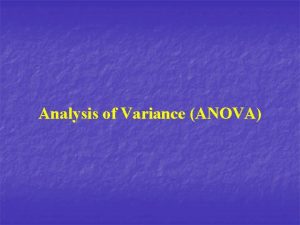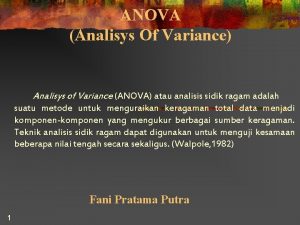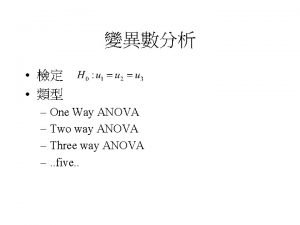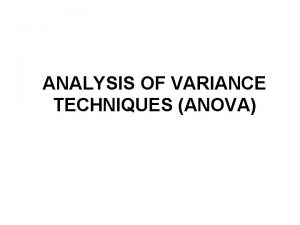One Way Analysis of Variance One Way ANOVA








- Slides: 8

One Way Analysis of • • • • • • • • • Variance

One Way ANOVA �In prior notes, we looked at data analysis strategies for when the researcher needs to compare two sample means. But, what if a researcher designs a study in which there are more than two samples (groups)? �Using the Single Factor Analysis of Variance technique in Excel, we can determine if there is a different between averages of multiple groups or if the averages are the same. If we have one independent variable, then we use the One Way Analysis of Variance.

In this example, we have data on stress levels from patients. The patients were randomly assigned to three different groups, and one group was given music therapy, one group was given relaxation therapy, and the other was a control group. The data is presented below: Music 0 6 2 4 3 Relaxation Technique 1 4 3 2 0 Control 5 6 10 8 6

Step 1 We’ve measured their stress levels on a scale from 1 -10, and we’d like to see if the three groups are the same or different. • Put the data into Excel.

Step 2 Click on Data Analysis Anova: Single Factor. �You are choosing Single Factor because you only have one dependent variable (stress level ) and three categories of independent variables (therapy type).

Step 3 • Select the input range and if you include the top row then be sure to check Labels in First Row.

• Click OK and the results of the ANOVA analysis are shown as below: Step 4 Anova: Single Factor SUMMARY Groups Music Therapy Count 5 Sum 15 5 5 10 35 Relaxation Technique Control Average Variance 3 5 2 7 2. 5 4 ANOVA Source of Variation SS df Between Groups 70 Within Groups 46 Total 116 MS 2 F 35 P-value F crit 9. 130434783 0. 003888652 3. 885293835 12 3. 83333 14

�Our null hypothesis is that there is no difference between mean scores of the three groups. �Our alternative hypothesis is that there is a difference between mean scores of the three groups. �Based upon the P-Value presented here, we see that 0. 003 is less than the alpha significance that we chose of 0. 05 when running the ANOVA analysis. Since it is less, then we must reject the hypothesis and conclude that the alternative hypothesis is correct, which means that there is a significance difference between the groups.















